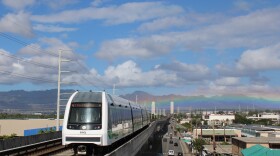WAIPAHU — Susan Galicha can see Honolulu’s rail cars being tested on elevated tracks just minutes from her home. Yet the Waikiki hotel housekeeper may never get to ride them to work and avoid the city’s horrendous traffic jams because the city doesn’t have enough money to finish building the rail line.
“It’s so sad for me to see that it’s only passing by back and forth, but the public cannot use it," Galicha said.
The rail line — one of the nation’s most expensive per capita — may have to end a long way from both downtown and the hotel district in a nondescript light industrial area featuring a bus depot and a highway interchange. It’s akin to a Las Vegas train ending far short of the strip or the New York subway bypassing Manhattan. Supporters want to finish it as planned, or at least build it as far as downtown, but the way forward isn't clear and won't be easy.
The latest cost estimate for the 20-mile (32-kilometer) rail line is $9.1 billion — nearly double the $5.5 billion budgeted at the time of the project's 2011 groundbreaking. Officials are worried the total may escalate further.
Currently, Galicha can ride an express bus that will take 30 to 45 minutes from her home in Waipahu to Waikiki, though with traffic the trip can top an hour. A regular, non-express bus would take up to two hours. A train ride from Waipahu to the planned end of the line on the edge of Waikiki would take 31 minutes.
That's if the full route is built.
The possibility it might not burst forth in recent weeks when it became clear the city didn't have enough money to finish it. Much finger pointing and hang wringing has ensued.
The Honolulu Authority for Rapid Transportation or HART, which is building the rail line, raised its cost estimate 10% to $9.1 billion. Around the same time, HART predicted tax revenues earmarked for rail construction will come in $423.5 million lower than expected over the next decade due to the pandemic.
Compounding the situation is the fear that the final 4-mile (6.4 kilometer) segment starting at Middle Street, the light industrial area, will cost far more than the $1.6 billion HART has estimated.
This has dramatically split the city administration and HART, a semi-autonomous city agency, who have been working on a joint project to team up with a private partner to build the final segment and operate the rail line.
The city pulled out of the joint project in August after its procurement officer saw bids submitted by prospective private sector partners.
Mayor Kirk Caldwell said state procurement law mean the procurement officer can't disclose bid details but he believes they were far more expensive than the city can afford.
HART CEO Andrew Robbins is moving forward with the project anyway, saying he wants more time to talk to the bidders to identify what's driving up costs and understand what could be done better. He will then ask for their final offers. He said he didn't want to pass up this valuable information after the agency has spent the last two years working on the private partnership.
“We feel it’s our professional responsibility to to hear from the bidders, understand whether the procurement from a proposal perspective is viable and could be viable, that could lead to an award and a contract,” Robbins said. He plans to make his recommendation by Nov. 13.
The mayor is anxious about potentially losing $250 million in Federal Transit Administration funding which is due to lapse at the end of the year if Honolulu doesn't show it has a viable plan to build the last segment.
Caldwell accused HART of “playing chicken” with the federal government's deadline.
He wants the city to start over and seek new bids without the private partnership, an approach he thinks will be more transparent.
Both the mayor and Robbins say one option might be to built the final 4 miles in phases, or build as much as the city can afford for now. That could mean going as far as downtown. Or perhaps all the way to Ala Moana on the edge of Waikiki but with fewer stations.
Rick Blangiardi, elected on Tuesday to be the city's new mayor, supports rail but has expressed concern about the possibility the final leg could cost $2 billion more than HART now estimates. He said in a statement that he would "prioritize increased transparency, accountability and open communications between all the stakeholders, including the taxpaying public.”
Council member Kymberly Pine, who represents the west Oahu suburbs where the rail line starts, blames some of the dysfunction on the decision to make HART an entity separate from the city. HART is governed by a volunteer 14-member board appointed by city and state leaders. The city government is accountable for what the agency does but has little authority over it, Pine said.
To her, building rail meant her neighbors wouldn't have to spend four hours a day round-trip on the road in their cars. They wouldn't have to kiss their kids goodbye when it's still dark in the morning and then return to them at night when it's dinner time.
She called the situation a "tragedy for the taxpayer, especially for my constituents who needed this project more than anybody."



